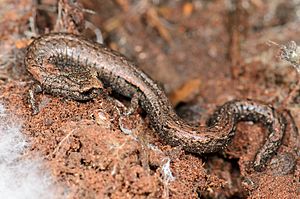Gregarious slender salamander facts for kids
Quick facts for kids Gregarious slender salamander |
|
|---|---|
 |
|
| Conservation status | |
| Scientific classification |
The gregarious slender salamander (Batrachoseps gregarius) is a type of salamander. It belongs to the family Plethodontidae, which means it breathes through its skin. This salamander lives in woodlands and grasslands. You can find it in the lower hills of the western Sierra Nevada mountains. It also lives in the eastern Central Valley in California, United States.
Contents
What Does It Look Like?
The gregarious slender salamander is a small, thin creature. It has a narrow head and short legs. Its hands and feet are small, and its tail is long and pointy.
Its back is usually brown. This brown band starts at its neck and goes all the way down its spine to its tail. The color can be light brown with dark spots or much darker. Its sides are blackish with tiny white dots. Its belly is a pale gray color.
Adult salamanders are quite small. They are less than 50 mm (2.0 in) long from their snout to their bottom.
Where Does It Live?
This salamander is endemic to California. This means it is only found there. It lives on the western slopes of the southern and central Sierra Nevada mountains. You can find it at high places, up to 1,800 meters (6,000 feet) above sea level. In the southern parts of its home, it usually stays below 900 meters (3,000 feet).
It also lives near rivers in the Central Valley. It is common in southern Tulare County and northern Kern County. These areas are near the White River and Arrastre Creek.
Its home can be different in various places. Often, it lives in open oak woodlands. Here, you might see interior live oak, blue oak, and foothill pine trees. Sometimes, it lives in mixed forests with ponderosa pine, incense cedar, white fir, and California black oak.
In the northern parts of its range, it lives in forests with sugar pine and giant sequoia trees. Near the Kern River in the south, it lives in dry grasslands with scattered rocks.
Reproduction and Life Cycle
These salamanders have a specific time of year for having babies. In warmer, lower areas, females lay eggs soon after the rainy season starts. In higher, cooler places, they lay eggs later.
The female hides her eggs in a safe, moist spot. This could be under tree bark, a fallen log, a rock, or in damp leaves. It's often near a wet area like a stream.
These salamanders often lay their eggs together in shared nests. Some nests have been found with over 300 eggs! This means more than 18 females likely laid eggs there. Bigger females usually lay more eggs. Females from the northern areas lay about 15 eggs on average. Those from the southern areas lay about 7 eggs.
The mother does not guard the eggs after they are laid. However, adult males and young salamanders might stay nearby for shelter. The eggs grow directly into tiny versions of the adult salamander. There is no larval stage, like with tadpoles. In a lab, it takes about 65 to 73 days for the eggs to hatch. It likely takes a similar time in the wild.
Conservation Status
The IUCN (a group that studies animal populations) says the gregarious slender salamander is of "Least Concern". This means it is not currently in danger of disappearing.
It lives in many different types of homes. Its population seems to be steady. There are no major threats to this species, except for when its home is destroyed.
See also
 In Spanish: Batrachoseps gregarius para niños
In Spanish: Batrachoseps gregarius para niños


